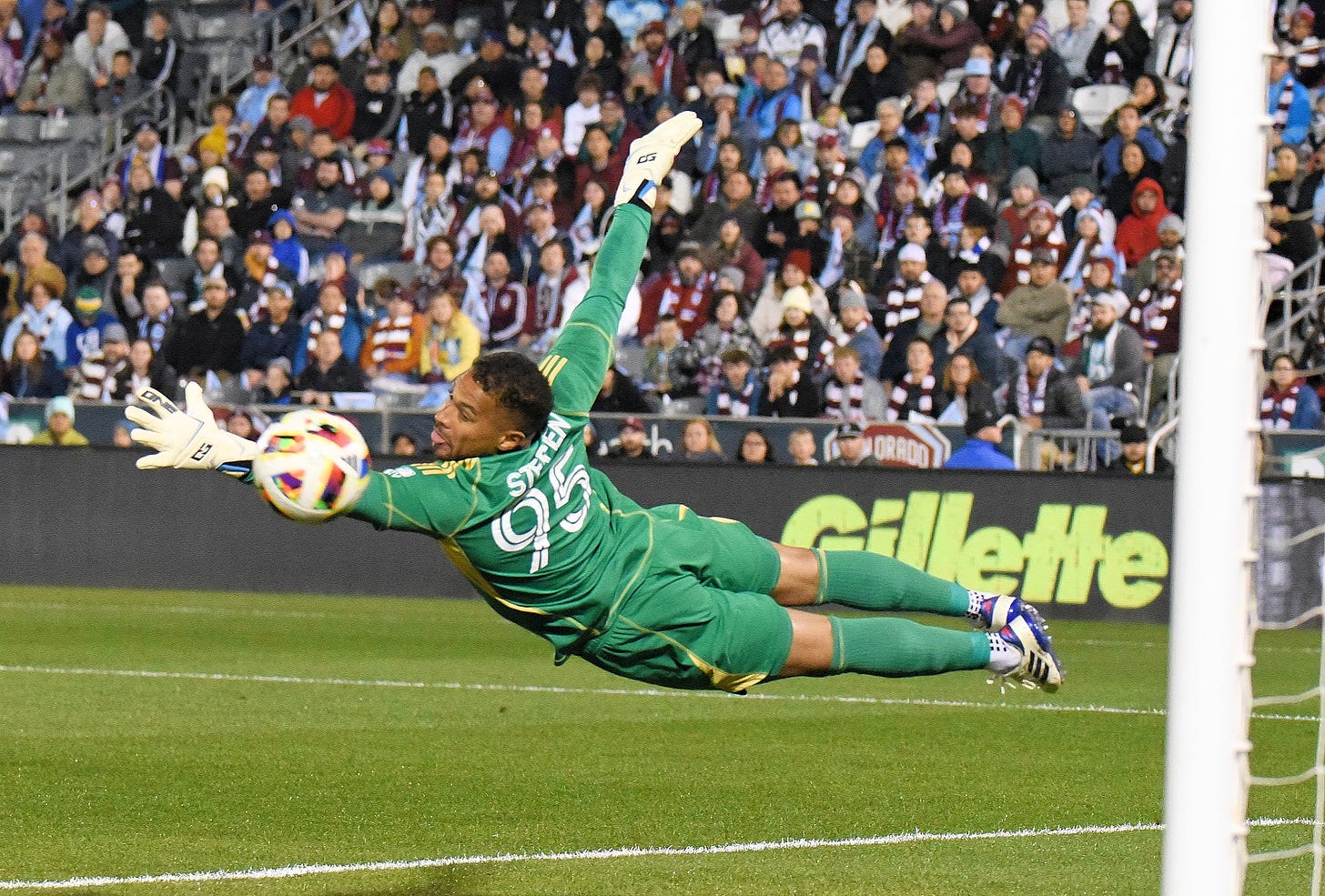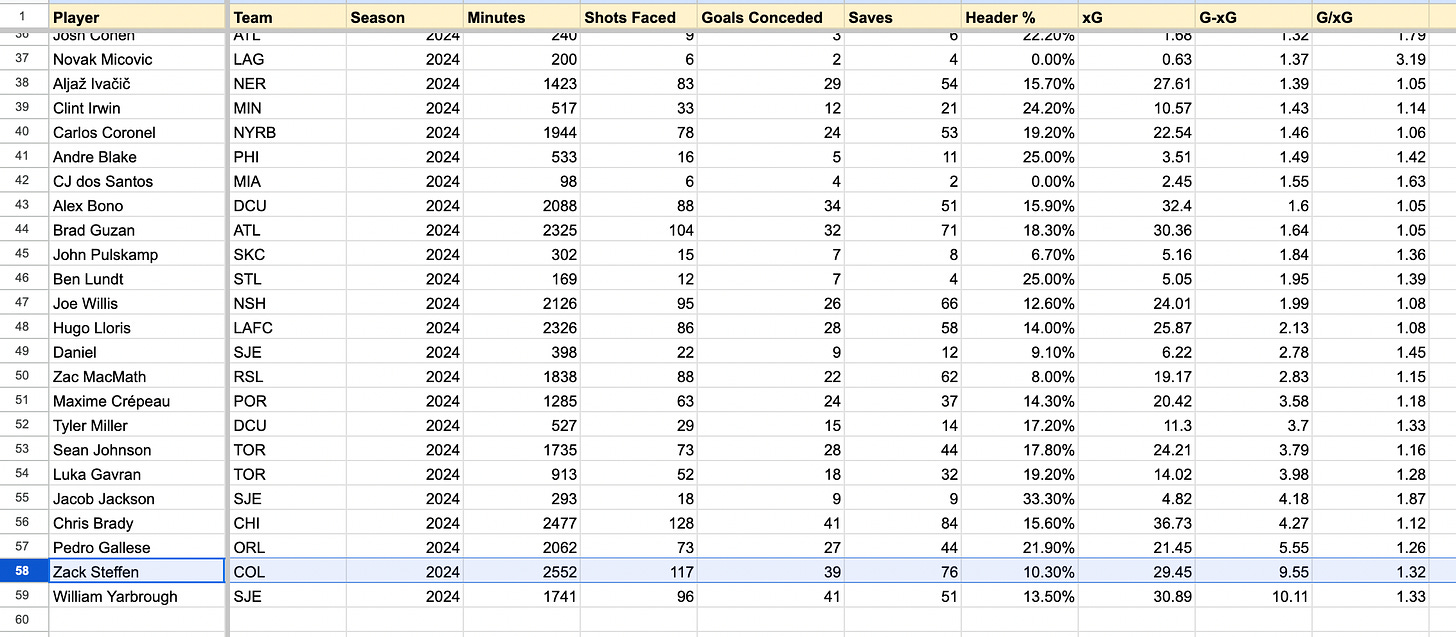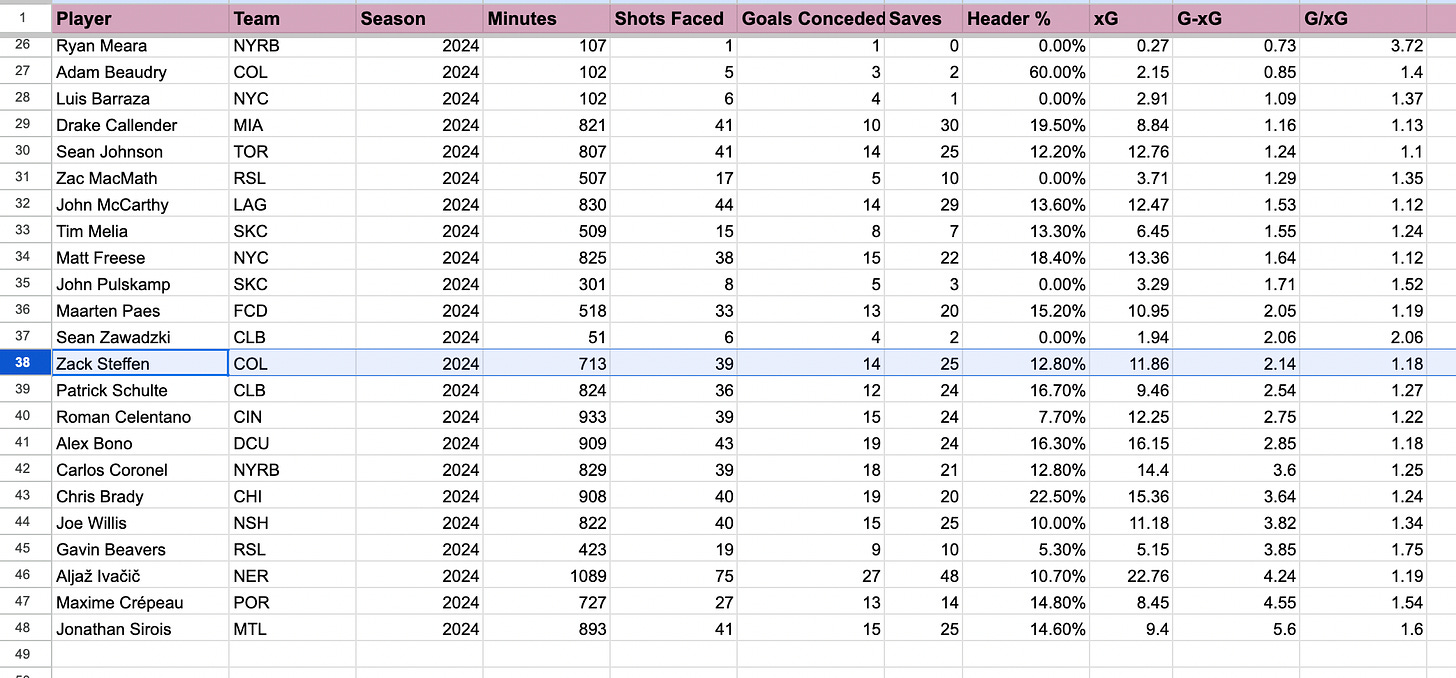The 2024 Colorado Rapids By the Numbers
Overall, Colorado had a great season; albeit one where there are things to improve upon. Looking back at the 34 game regular season, what do the numbers tell us?

Settle in for a long read, friends, because here, in all its glory, is an epic deconstruction of what went right, and wrong, with the Colorado Rapids in 2024. Overall, the season was ‘a success’, but we’ll always be left wondering if there weren’t some ways in which it might have been better.
The 2024 Colorado Rapids were rebounding from two poor seasons in 2022 and 2023; they had added some new players, and a new coach, and it was unclear what we should expect as fans. What we got was a winning season (15-5-14 WTL); a Leagues Cup Semi-final appearance which also gave us a 2025 Concacaf Champions League berth; and the team’s first playoff appearance since 2021. Additionally, Oliver Larraz’ belter of-a-goal against LA Galaxy was the first Rapids playoff goal since 2016.1 All in all, pretty decent year.2
I always thought the Chris Armas era for the Rapids, and the path to a trophy, was going to be a two-to-three year project. Year one was a success, albeit a limited success. We did learn a few things, too, about what worked and what didn’t in 2024.
Here comes a lot of numbers. If you’ve read my stuff before, you know I love me some advance metrics. All the numbers below are from American Soccer Analysis. I’ll explain a little bit what they mean as we go, but I want to add that numbers without soccer-watching context are meaningless. I’ve watched enough MLS to know that some of these metrics are more meaningful than others. Additionally, the way some of these stats are calculated, both Expected Goals (xG) and Goals Added (G+), have some subjectivity to them. That’s because certain actions are *weighted* more than others - and ASA weights things differently than fotmob, MLSsoccer.com, or Opta. But I trust them, because a) I wrote for them for a few years and b) a bunch of the really smart guys that created these numbers now work full time in the analytics departments for MLS teams.
Here’s them numbers:
Colorado Rapids Goals Added (G+), 2024
Colorado Rapids xG and xA, 2024
And here’s a variety of observations:
1. Our team’s most valuable player is Cole Bassett
You might make an argument that I’m giving in to confirmation bias here; that because I’ve been talking up Cole Bassett all year, that because I interviewed him, and because I’m always talking about him on the podcast, that I just went ahead and declared him our best because conveniently I just happened to have some numbers that supported my already long-existing love of Bassett.
Not really! Math, simply, does not lie; and Bassett lead the team in Goals Added (G+). If you’re unfamiliar with Goals Added, this metric takes all the actions that go into a goal – the forward dribbles, the passes, the tackles, the recoveries, everything, and based on where they occur on the field it translates those actions into a number of how likely that is to lead to a goal. The numbers are adjusted to ‘above average’, with average being 0.0. MLS’ best player this year was Riqui Puig, who had an 8.06 Overall G+. Cole Bassett’s 2.06 was best on the Rapids. The worst player in MLS was, shockingly, former Mexico international Alan Pulido, with a -3.38 G+.3
Bassett’s Receving, Shooting, Passing, and Dribbling G+ were all pluses, on average. He’s the second-best dribbler on the team behind Rafa Navarro; he’s the second-best receiver on the term to Kevin Cabrál; and he’s the best shooter on the team. His weakness is Interrupting G+, the measure of tackles, interceptions, recoveries and blocks in relation to where those valued events occur on the pitch. Bassett seems to have been switched into ‘attack’ mode by the coaches, and either that is aiding his ability to attack, or it’s an area to devote attention to in 2025 in order to become a better all around player. Still, in 2024, he was here, he was there, he was every f***ing-where.
2. Rafa Navarro wants to take it to the paint
Some strikers are pop-up guys - they rush into a spot and one-time it into the net. Thomas Müeller is the archtype. Other guys have a nose for where to bang in a rebound. That was Chris Wondolowski. Some guys are built to dunk on you in the air. That’s Kei Kamara. Other guys want to wind up 25 yards out and curl it into the top corner. Lionel Messi, Sebastian Giovinco, David Beckham.
Rafa wants to get the ball at his feet, shake his man in 8 to 15 yards, and bury it past the keeper. His +1.66 Dribbling G+ was seventh in all of MLS in 2024. It was better than Messi (+1.24) and better than Dennis Bouanga (+0.65). Rafa converted his chances for 15 goals, third-most in a single season for a Rapids player. It works for him; the team clearly knows how to feed him the ball in a spot he can capitalize on. Rafa could stand to improve his finishing a little; his xG was 17.92, which means he underachieved a little on what the algorithm thinks another MLS striker with his chances should finish. It’s a little unfair to compare him to Messi, the indisputable GOAT, but … Messi’s xG this season was 11.74, and he scored 20 goals for a G-xG of +8.26. If Rafa did that, he’d win the Golden Boot.
It’s a great sign.
3. Going from Moïse Bombito to Lalas Abubakar was a big downgrade
We all knew that the Rapids weren’t going to be as good without Moïse Bombito, but I don’t think we knew how big a downgrade it would be until it happened. And so it was that, results-wise, Colorado fell off in a measurable way when Moïse departed. Colorado was 3-0-7 (WTL) in the regular season after Moïse Bombito left for OGC Nice. They were 12-2-7 before that.4 On the season, Moïse Bombito produced a +0.36 G+, including a +0.72 Interrupt G+. Lalas Abubakar, on the other hand, produced the worst G+ on the team, with a -1.58.
This also marks Lalas’ worst season with the team; here’s his last four seasons.
That 2023 tot 2024 decline from -1.37 to -1.58 isn’t huge. But take that with the data point that the team’s 60 Goals Against was fourth-worst in the Western Conference, and suddenly it looks like the Rapids backline is a problem (we’ll talk about the fullbacks later.)
Chris Armas’ more attacking style means defenders are going to have to bail the team out on occasion. Losing their super-fast centerback most definitely caused some harm.
4. All the cool stuff Cole Bassett did this year only matters in the wins column because of Djordje Mihailovic
Colorado had Cole Bassett in 2023, and he was pretty good then, too. What he didn’t have was a man to set ‘em up, and a man to knock ‘em down. The knock down guy we’ve already spoken of; that would be Rafael Navarro. The set up guy was Djordje Mihailovic.
Mihailovic 19.96 Expected Goals plus Expected Assists (xG+xA) was second most on the team to Rafa, but 17.92 of his 20.05 xG+xA is just xG. Rafa just wanted to score goals; he only passed off a chance in the rarest of moments. Djordje, meanwhile, produced a very even 11 goals and 9 assists5 for a career high – better than his fantastic 2021 season with CF Montreal where he had 4 goals and 13 assists.
At $1.675 million, Mihailovic is a luxury item. He holds one of the team’s previous DP slots. He was definitely worth it in 2024.
5. The central pivot to the attack was … Connor Ronan?
I have to say, I’ve been watching defensive midfielder Connor Ronan, and my overall impression of him is: tidy with the ball, hardworking, maybe a touch slower than I’d like, and mostly I don’t notice him. Do I not notice him because he’s underwhelming? Do I not notice him because he doesn’t make big mistakes? I dunno.
According to the numbers, Ronan is Colorado’s best passer, with a Passing G+ of +1.51. Remember, that doesn’t mean he’s a perfect passer - it means he makes the right amount of successful risky passes vs successful (or unsuccessful) sideways or backwards passes that add very little to G+. In the Rapids 4-2-3-1 double pivot, he’s actually … the single pivot. While Larraz and/or Bassett and/or Mihailovic are running around crazy tackling and dribbling and crashing the box, Ronan is sitting deep in his armchair, recirculating the ball into the right place or threading the right pass into a dangerous spot. It won’t end up in the scoreline – Ronan had 1 goal, 1 assist in 2024 – but it is eminently valuable. Hopefully someone directs his agent to this substack at contract time to note that he’s been really important to this team. (If that happens, Mr. Agent, and Ronan gets a new $1 million contract, I’ll take a gift certificate for a steak dinner or a signed kit, please.)
6. The fullback position is an area of concern
Here’s the collected G+ of the Rapids, by position:
Strikers: +1.76
Attacking Midfielders: +1.50
Defensive Midfielders: +1.48
Wingers: +0.57
Centerbacks: -0.78
Fullback: -0.84
Remember that G+ is a stat that really attempts to describe the total contribution of a player in all relevant aspects to both scoring and conceding goals. So an amazing attacker with serious defensive liabilities has been evaluated numerically for both his strengths and shortcomings, and ideally, G+ produces a relatively accurate measure of their value. Take all the position players together, and you can see whether we’ve got a problem at one specific spot.
I was surprised that our strikers are our best asset, and even more surprised that Darren Yapi had a +0.97 Overall. But the kid is good at pressing, good at dribbling, and despite having only 2 goals on the season, xG only expected 2.28. The kid was productive, even though he probably wants more goals. I want more goals for him, too.
The centerbacks, with that negative number, might be an area of concern, except that if you subtract -1.58, they’re fine. So, uh, it’s not the centerbacks really.
The fullbacks, however, are a concern. We’ve long held that Keegan Rosenberry was a ‘stay at home’ right back; a defender’s defender. This year, his passing was considerably solid, as his Passing G+ of +0.43 was 9th amongst all MLS fullbacks. He also lead all Rapids fullbacks in Key Passes (17) and xG+xA (3.21).
But Keegan was 112th overall among MLS fullbacks in Total G+ at a -0.66 Total G+. It was his Interrupting G+ that killed his overall number: he had a -0.46 Interrupting G+, which was a putrid 129th amongst FBs, and there are only 143 FBs in MLS.
Those of us who watched every Rapids games will see this number rings true. This was maybe the second year in a row I notice Rosenberry getting beat in the final third a few times too many. That used to be his primary asset - he was a lock-down final third guy; and as a bonus, he was also tidy in possession and smart with advancing the ball with passes. Now it seems like his final-third defense is a liability. I will add, of course that nothing exists in a vacuum. Rosenberry’s interrupting number is inextricably linked to the defensive performances of everyone around him, and primarily the players closest to him. If Lalas or Ollie blows a defensive assignment, and Rosenberry becomes the last thing between Portland’s Evander and a goal, whelp, its not all Keegan’s fault. Interrupting G+ should account for that to some degree: every miracle saving throw Rosenberry makes when someone else screws up should contribute to a higher overall G+. But there’s a lot of moving parts.
Still, I trust this number, and my eyes, and I’m concerned that Rosenberry probably isn’t starting FB-caliber for a winning team anymore.
The other four fullbacks on the team; Sam Vines (+0.12 Total G+), Jackson Travis (-0.17), Sebastian Anderson (-0.15), and Reggie Cannon (+0.02); weren’t much better. Anderson’s only 22 years old, and Travis is only 20, so there’s still some potential there, and Cannon barely had time to adjust after a September transfer from QPR in the English Championship, so they get a pass. Vines had a very up and down year: looking really messy in the early part of the year and then looking decent as things went on. But in summary, I really was let down by this group. I’m a massive proponent of the importance of fullbacks in modern football. For sure you can win MLS Cup without having all-stars at those positions, but if you’re going by the numbers, this is the area that most needs addressing on the roster for 2025.
8. Goalkeeper: *Grumble Grumble*
There are actually three Zack Steffens.
There is the Zack Steffen from February 1 to July 20, when Leagues Cup began. That Zack Steffen, according to advanced metrics, was bad Zack Steffen. Here are his numbers:
Steffen was 57th out of 58 goalkeepers in G-xG, the measure of ‘shots the average goalkeeper keeps out of net’. Zero is dead average; negative is good, positive is bad. The best keeper in MLS through July 20 (not pictured) was NYCFC’s Matt Freese with a -7.76 G-xG. Steffen’s G-xG was +9.55; only former Rapid William Yarbrough was worse.
Of course, G-xG only measures Steffen’s shot-stopping ability. There are other things that keepers do, like accurate long kicks, passing, claims on crosses, and the unmeasurable act of ‘marshalling the defense’. Still, for my money, a goalkeepers main job is to position himself to stop shots, and then … stop shots. Steffen was not good at it.
Then there was ‘Leagues Cup’ Steffen. The Rapids got shellacked by Portland in the opener and then got a draw against Club Leon. And then from August 9 to August 25, the Rapids beat three Liga MX teams in a row: they beat Juarez 3-2, and Toluca 2-1, and then league juggernaut Club America 0-0 on PKs (9-8) in front of a sold out Los Angeles crowd that was 99.8% made up of America fans. Colorado then lost to LAFC before beating Philadelphia on PKs to get 3rd place and a berth in the 2025 Concacaf Champions Cup.
Steffen was brilliant throughout, and especially in the shootouts. There are no advanced stats on Leagues Cup, but any Rapids fan will tell you that Zack shined brightly.
And then there was ‘end of season Steffen’, which coincides with the Rapids being without Cole Bassett, and without Moïse Bombito, which makes it hard to separate cause and effect, here, because even though G-xG is a great stat, in my experience, teams with bad defenses tend to have goalkeepers with bad G-xG numbers.6
Here’s Steffen’s numbers, August 20 onward:
37th out of 47. Not great, but better!
Was Steffen adjusting to MLS? Was he learning his defense? Is he improving? Is the sample size too small August to October to make a meaningful inference? Would I have a different opinion of it all if I had G-xG numbers from Leagues Cup to factor in?I dunno.
I’m tough on goalkeepers, and especially tough on expensive and well-paidgoalkeepers. My platonic ideal keeper is 2019/2020 Matt Turner. We’re talking about an undrafted kid from Fairfield University who got signed by the New England Revs in 2016, make roughly league minimum, and then was a two-time finalist for MLS Keeper of the year. His advanced metrics were off-the-charts good; in 2020 he had a -8.37 G-xG; second place’s Sean Johnson had a -3.79. That’s why Arsenal came calling; thats why he became the #1 GK for the USMNT.
I don’t mean by this that the Rapids should spend big for Matt Turner. I mean: go homegrown. Go cheap. America produces tons of good domestic keepers. I suspect that Colorado has a couple on the roster right now. I also suspect that the top three keepers in USL this year, or the top five backup keepers in MLS would have been better than Steffen.
Maybe he just needs to adjust. His contract is through 2026, so whether we like it or not, I guess time will tell.
Colorado made the playoffs in 2020 and 2021, but exited without scoring a goal. They scored goals against LAG and
However, no hardware.
Pulido’s Passing G+ was a -1.18 and his Receiving G+ was -1.14. Meaning, compared to any other attacking player in the league, giving the ball is more likely to result in a turnover than anyone else. Yikes.
Mild caveat here is that Colorado had a great performance in Leagues Cup, without Bombito.
Fotmob has him at 10 assists?
I think that makes sense. If the backline is poorly positioned or fails to make a tackle or interception, they are also likely to give up shots in better spot or not defend the shots that well. There’s a world where a Team A concedes twice as many shots as Team B, but the GK of Team A is just fantastic and that means his G-xG is better. However, in general, if a team concedes a lot of shots, they also concede a lot of high-value shots, or expose more of the goal to an attacking player. In other worse, a bad defense almost always makes it look like a a team has a bad goalie, whether he actually was bad or not.









